
About UsThe Numismatic Bibliomania Society is a non-profit organization devoted to the study and enjoyment of numismatic literature. For more information please see our web site at coinbooks.org SubscriptionsThose wishing to become new E-Sylum subscribers (or wishing to Unsubscribe) can go to the following web page link MembershipThere is a membership application available on the web site Membership Application To join, print the application and return it with your check to the address printed on the application. Membership is only $20 to addresses in the U.S., $25 for First Class mail, and $30 elsewhere. For those without web access, write to: David M. Sundman, Treasurer
AsylumFor Asylum mailing address changes and other membership questions, contact David at this email address: dsundman@LittletonCoin.com SubmissionsTo submit items for publication in The E-Sylum, just Reply to this message, or write to the Editor at this address: whomren@gmail.com BUY THE BOOK BEFORE THE COIN |
- WAYNE'S WORDS: THE E-SYLUM JANUARY 11, 2015
- NEW BOOK: THE ECUADOR REGISTER PART II
- NEW BOOK: THE BANKNOTE BOOK
- NEW BOOKS IN THE MONETA SERIES: #180-182
- STERLING RACHOOTIN
- ALEXANDER A. CLAIN-STEFANELLI, 1943 - 2014
- PARTRICK 1792 CHALLENGE RESULTS
- BOSTON TIME CAPSULE OPENED
- NOTES FROM E-SYLUM READERS: JANUARY 11, 2015
- SUPERIOR PHOTO OF O-130 1795 HALF DOLLAR SOUGHT
- MORE SMALL COINS
- MORE ON BERT COHEN AND MACERATED CURRENCY
- REMEMBERING OSCAR PEARL
- THE 1863 ALUMINUM POSTAGE CURRENCY PATTERNS
- DAVID J. MALLOY'S CUSTOM COIN BOARDS
- CREMATORIUM IDENTIFICATION TAGS
- Q. DAVID BOWERS AND NUMISMATIC WRITING
- STACK’S BOWERS TO TEAM WITH SOTHEBY’S
- SOME INTERESTING MEDALS: JANUARY 11, 2015
- BERMAN COLLECTION OF POLITICAL MEMORABILIA
- MONNAIE DE PARIS ADDS A DINING DESTINATION
- MORGAN DOLLAR MODEL ANNA WILLESS WILLIAMS
- WWII JAPANESE COUNTERFEITING OF CHINESE CURRENCY
- MACQUARIE UNIVERSITY INVESTIGATES ANCIENT COIN MANUFACTURING
- SOME RECENT COIN DESIGNS: JANUARY 11, 2015
- PSYCHOLOGIST TRAINS MONKEYS TO USE MONEY
- WORST. COUNTERFEIT. EVER.
- MAN AWAKING FROM COMA REACHES FOR BANKNOTE
- FEATURED WEB SITE: GUATEMALAN COINS
Click here to access the complete archive
To comment or submit articles, reply to whomren@gmail.com
WAYNE'S WORDS: THE E-SYLUM JANUARY 11, 2015

New subscribers this week include: Nancy Wooten, courtesy of Bob Fritsch; J. Fred Maples, David Clayton, Daniel Williams and Mike Schmidt. Welcome aboard! We now have 1,809 subscribers.
This week we open with five new numismatic books, the loss of Sterling Rachootin and Alex Clain-Stefanelli, the Partrick Challenge results and the Boston time capsule opening.
Other topics include the Overton-130 1795 Half Dollar, Oscar Pearl, aluminum postage currency patterns, the Monnaie de Paris, Morgan dollar model Anna Williams, World War II Japanese counterfeiting of Chinese banknotes, ancient coin manufacturing methods, and Guatemalan coins.
To learn more about The Banknote Book, a porcupine’s quill, tiny medieval Russian coins, minimissimi, McKenzie’s three punters medallion, monkey money, a funeral director's custom penny boards, crematorium identification tags, and the worst counterfeit banknote ever, read on. Have a great week, everyone!
Wayne Homren
Editor, The E-Sylum
NEW BOOK: THE ECUADOR REGISTER PART II
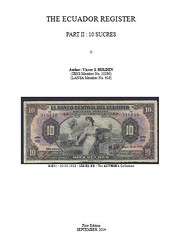 'THE ECUADOR REGISTER - AN ONGOING CENSUS OF THE BANKNOTES OF THE BANCO CENTRAL DEL ECUADOR
ISSUED FROM 1928 TO 1980 (together with a Listing of the post-1980 Issues which are not included in the Census)' - PART II : 10 SUCRES
'THE ECUADOR REGISTER - AN ONGOING CENSUS OF THE BANKNOTES OF THE BANCO CENTRAL DEL ECUADOR
ISSUED FROM 1928 TO 1980 (together with a Listing of the post-1980 Issues which are not included in the Census)' - PART II : 10 SUCRES
Full names of Signatories, where known, numbers of notes issued for each Date, Series and Signature Combination, together with URS ratings and all known Varieties and Errors.
Victor S. HOLDEN, 59 pages with comb binding, published by the author, Hong Kong, China, September 2014. List price US$50 (including S&H) available from the author at ecuadormanhk@yahoo.com.hk; payment via PayPal.
NEW BOOK: THE BANKNOTE BOOK
 Owen W. Linzmayer, The Banknote Book. Spink / London 2014. 22 x 28 cm. 2355 pp., color
Owen W. Linzmayer, The Banknote Book. Spink / London 2014. 22 x 28 cm. 2355 pp., color
There are people who live their passion. Apparently, Owen W. Linzmayer, writer of a new reference work on banknotes published by Spink in 2014, is one of these. He maintains the website www.banknotenews.com, which – when compared to the impressive, three-volume catalog recently published by Spink – is a perfect testimony to the change the work of an author has undergone in the previous decades.
Let’s start with the aim of this project. Owen W. Linzmayer plans to assemble all officially issued banknotes of every country in the world in a huge, exemplary catalog. His work is characterized by detailed information with an accurate description of the banknotes, first-class images, names of the printers, and additional notes on products designed specifically for collectors. In addition, the author provides numismatic comments on the different emissions. That makes this work considerably more detailed than any other transnational catalog.
At the end of each chapter the experts which assisted the author in writing the relevant chapter are mentioned by name. The catalog is completed by a lengthy list of bibliographic sources and the request to share one’s knowledge with the author.
This catalog is special because it is not finished yet. Rather, it is a published – albeit already highly impressive – intermediate result (as of August 2014) of the project that aims for completeness. The author is assembling the images and the material for the subsequent chapters and asks all users of this catalog both for their help and for scans.
The Banknote Book is a typical catalog project that would have been impossible to undertake prior to the internet era. A central author standardizes information he has gathered from collectors, dealers, experts and, naturally, from books, and then compiles a catalog of a hitherto unparalleled level of quality. By the way, this catalog is of course likewise a price guide with thoroughly researched prices given for all listed banknotes in three conditions.
Thus, we advise every collector of banknotes to go for the double pack: buy the printed version of the three volumes for £60 only at Spink, and, in addition, subscribe for $99 per year in order to get all updates until Spink publishes the next printed edition. You can also buy and download individual chapters on the website which only pays off if you harbor very special interests. After all, the price of every chapter counting 10 or more pages is already $9.99.
The Banknote Book is a true asset not only to the library. The approach that has been taken to compile this catalog is likewise remarkable. It is a new way that can help undertake projects that are too complex for a single author.
To order the books from Spink, see:
The Banknote Book by Linzmayer, Owen W.
(www.spinkbooks.com/product.php?xProd=514&xSec=10)
To read the complete article, see:
The Reference Work on Banknotes: The Banknote Book
(www.coinsweekly.com/en/News/4?&id=3201)
To read the earlier E-Sylum articles, see:
THE BANKNOTE BOOK CELEBRATES FIRST ANNIVERSARY (www.coinbooks.org/esylum_v15n31a08.html)
BOOK REVIEW: THE BANKNOTE BOOK (www.coinbooks.org/esylum_v15n11a05.html)
NEW BOOKS IN THE MONETA SERIES: #180-182
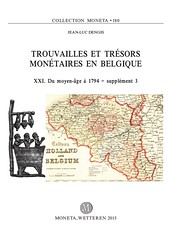
Moneta 180
J.-L. Dengis, Trouvailles et trésors monétaires en Belgique, XXI. Du moyen-âge à 1794, supplément 3, Collection Moneta, 180, Wetteren, 2015,
338 p., ISBN 978-94-91384-48-6
For more information, or to order, see:
www.moneta.be/volumes/moneta_180.htm
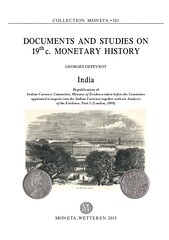
Moneta 181: Indian Currency Committee, Part I
Indian Currency Committee, Minutes of Evidence taken before the Committee appointed to inquire into the Indian Currency together with an Analysis
of the Evidence, Part I (London, 1898), G. Depeyrot, ed., Collection Moneta, 181, Wetteren, 2015, 346 p ISBN 978-94-91384-49-3
For more information, or to order, see:
www.moneta.be/volumes/moneta_181.htm

Moneta 182: Indian Currency Committee, Part II
Indian Currency Committee, Report of the Committee appointed to inquire into the Indian Currency Minutes of Evidence taken before the Committee,
Part II Index and Appendices to the Evidence (London, 1899), G. Depeyrot, ed., Collection Moneta, 182, Wetteren, 2015, 556 p ISBN
978-94-91384-50-9
For more information, or to order, see:
www.moneta.be/volumes/moneta_182.htm
MONETA publishes books on numismatics, monetary history, economy, from antiquity to present, all continents, all languages, see www.moneta.be.
Order on Moneta www.moneta.be with Paypal Order on disdocs http://disdocs.com/index.php?manufacturers_id=11 with Visa and MasterCard

STERLING RACHOOTIN
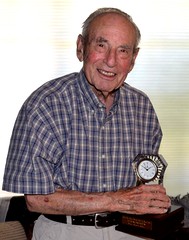 In the mid 1930s, when the penny boards just came out, a few of my friends
bought them and began collecting. I thought it was a great idea, especially when my father bought a neighborhood grocery store and I had the
opportunity to try and fill my penny board. That was not to be.
In the mid 1930s, when the penny boards just came out, a few of my friends
bought them and began collecting. I thought it was a great idea, especially when my father bought a neighborhood grocery store and I had the
opportunity to try and fill my penny board. That was not to be.
My father was in fact dealing in pennies, also, and he felt that I was in competition with him by taking pennies out of his cash register. On a 15-cent pack of cigarettes, 2 cents was the profit margin, so I had to get rid of my penny board. My dad worked very hard from 6:30 a.m. to 9:30 p.m., seven days a week, with one day off each year — Yom Kippur. He had to retire after his heart attack in 1944.
By 1960 I was a married man with three children. One evening, while walking through a Sav-On drug store, I noticed a thick, three-holed notebook filled with pennies in 2x2 holders. In one corner were marked prices ranging from 10 cents up to $3.50, and in the opposite corner was the date and mint mark.
In my mind, I was thinking, "I must be throwing away a fortune in pennies."
So I immediately purchased a Whitman holder, some 2x2 coin holders and a copy of Dick Yeoman's "Red Book" ("A Guide Book of United States Coins").
Dad's grocery store was no longer available to me, but I was in "good" with the cafeteria manager of our school where I taught, and she sold me her daily take of change.
A few weeks passed and I had my penny folder almost complete, except for 12 empty slots. I needed the 1909-S VDB, 1914-D and some of the scarcer pieces.
Just out of curiosity, I went to a nearby coin store and inquired as to what the 12 slots would cost to complete my set of cents. The dealer added up the cost on his calculator and it came to $375.
The dealer saw I was not impressed, so, wishing to make a sale, he said, "I have a complete set of Lincoln cents in a Whitman folder I just bought, that you can have for $300." I purchased the set of Lincolns just to prove to myself that I was a serious collector. I still have it.
My father-in-law had just moved to Los Angeles from Monaco and I noticed he brought with him a gumball machine filled with pennies. After a hint, he gave me the machine, but I couldn't open it. So I smashed it open to obtain some 40 pennies — all common ones. The gumball machine was worth some $75, however.
This incident only verifies my commitment to numismatics. Needless to say, I progressed to nickels, dimes, quarters and dollars, which were still common in Las Vegas. In the gumball machine was a strange copper-like coin, so I made a trip downtown and visited several coin stores to learn what I had found.
The first three coin dealers could not identify the token, but the fourth dealer informed me I had a Civil War token. I was so excited that I bought two black books by Fuld for $1 each, and I began collecting Civil War tokens. Then I met Jack Detwiler, who encouraged me to write articles for the Civil War Token Society. I joined the society, served on the board of governors, and a few years later I was elected vice president and later as president.
My collecting enthusiasm did not end there. After meeting another numismatist, George Baude, I became interested in many new fields of numismatics. I became excited with encased postage, followed by privately issued scrip and postage stamps of the Union and confederacy of the Civil War era, then patriotic covers and the interesting propaganda messages contained therein.
There was inflationary money appearing after World War I, with its anti-Semitic, Nazi propaganda. I was on a roll, and almost everything proved to be exciting: counterstamped coins, love tokens, Conder tokens from England, Hard Times tokens, cobs, and most recently, items not used for commerce made from coins and currency.
I have not collected coins from every field yet, but I seem to be swayed by every field of numismatics. If I live long enough, there are many more fields that will excite me. I just remembered — I delved into the field of errors and off-metals earlier and helped a few get started in that field. When I taught elementary school, I usually provided material to after-school stamp and coin clubs that met weekly, gratis. If money and health hold up, I'll be into more new fields.
To read the complete article, see:
A Conversation with Sterling Rachootin, Modern Renaissance
Collector (www.scvhistory.com/scvhistory/signal/coins/soltaylor011908.html)
Susan Trask also forwarded this entry for Sterling on the CWTS Hall of Fame:
Sterling Rachootin undoubtedly has written more articles and received more Literary Awards at all levels than any other author contributing to The Civil War Token Journal. A history teacher by profession, Sterling brought historic interpretations to his articles, often challenging the reader to do research and writing of his or her own. He served on the Society's Board of Governors for five terms, and as President in 1997- 1998.
ALEXANDER A. CLAIN-STEFANELLI, 1943 - 2014
 In September 2011 E-Sylum subscriber Alex Clain-Stefanelli attended a meeting of my northern Virginia numismatic social group, Nummis Nova. I
had met him briefly at a coin show many years earlier, where he was introduced to me by his mother, Elvira Clain-Stefanelli. She and his father
Vladimir were curators of the National Numismatic Collection at the Smithsonian Institution for many years.
In September 2011 E-Sylum subscriber Alex Clain-Stefanelli attended a meeting of my northern Virginia numismatic social group, Nummis Nova. I
had met him briefly at a coin show many years earlier, where he was introduced to me by his mother, Elvira Clain-Stefanelli. She and his father
Vladimir were curators of the National Numismatic Collection at the Smithsonian Institution for many years.
I'd never gotten to know him, although he was familiar to several of our members. He'd worked in Gene Brandenburg's coin shop in Alexandria for a time and had come as Gene's guest. I was sad to learn on Monday of his passing. Andy Singer had noticed his death notice in that morning's Washington Post. -Editor
His family background was quite unique; while pregnant with him, his mother was at the Buchenwald concentration camp. Here's an excerpt from her obituary:
Elvira Eliza Olinescu was an author, curator, critic and, above all, a survivor. Born in Bucharest, Romania, at the beginning of World War I, she and her family were forced to flee their village to avoid invading troops. At the end of the war, she returned home to the disputed territory between Austria and Romania. She would later earn a master's degree in history from the University of Cernauti in Romania.
In 1939 she married Vladimir Clain-Stefanelli, a postgraduate student in Rome, who specialized in ancient coins. The couple was researching coins in Germany in 1942 when Vladimir was arrested by the Gestapo because his passport had been stolen and "used by an enemy of the state." He was sent to the Buchenwald concentration camp where he remained "a guest" until the end of World War II. Although pregnant, Elvira chose to join her husband in the camp. She later was released so their child would not be born in prison; however, after experiencing the bombings in Berlin, she returned to the camp, thinking it safer. She didn't realize Buchenwald, the site of a V-2 rocket factory, was a target for Allied bombings.
After the war, Vladimir found work in Rome with the numismatic firm. The family arrived in the United States in 1951 and the couple worked in New York for several years for Hesperia Art, then later for Stack's Rare Coins. In 1956 Vladimir became curator of the Smithsonian's Division of Numismatics; a year later, Elvira became his assistant. Two years after Vladimir's death in 1982, she became the department's first executive director.
To read the complete obituary for Elvira Clain-Stefanelli, see:
ELVIRA CLAIN-STEFANELLI, CURATOR AT
SMITHSONIAN INSTITUTION, DIES (https://www.money.org/uploads/pdfs/press-releases/2001/ANAPR.10.05.01-Elvira-Clain-Stefanelli-Dies.pdf)
To read the complete death notice for Alex Clain-Stefanelli, see:
ALEXANDER A.
CLAIN-STEFANELLI (www.legacy.com/obituaries/washingtonpost/obituary.aspx?n=alexander-a-clain-stefanelli&pid=173655359)
To read the earlier E-Sylum articles, see:
WAYNE'S NUMISMATIC DIARY (www.coinbooks.org/esylum_v14n39a13.html)
NOTES FROM E-SYLUM READERS: MARCH 11, 2012 : The Smithsonian's Trove of Numismatic
Rarities (www.coinbooks.org/esylum_v15n11a13.html)
PARTRICK 1792 CHALLENGE RESULTS
In December Pete Smith wrote:
 I
propose the Partrick 1792 Challenge. Heritage will be selling the Donald G. Partrick 1792 patterns during their FUN auction beginning January 7,
2015. The twelve coins are lots 5501 through 5512.
I
propose the Partrick 1792 Challenge. Heritage will be selling the Donald G. Partrick 1792 patterns during their FUN auction beginning January 7,
2015. The twelve coins are lots 5501 through 5512.
I intend to predict what each of the lots will realize at the sale. I propose to send my predictions to Wayne prior to the sale. I invite anyone else to also submit their estimates to Wayne. Let's go with hammer price to keep it somewhat more simple.
On Monday Alan V. Weinberg wrote:
I've specialized, among other fields, in 1792 American pattern coinage for many decades and I'd imagine I'm as attuned to the American classic coin market as much as anyone, attending most of the major shows and auctions going back to the 1960's.
But I have absolutely no idea how the Partrick 1792 patterns will do. The following are factors that significantly cloud the forecasts:
There is a veritable avalanche of rare top quality classic U.S. flooding the marketplace for the past year and this will continue into 2016 with Pogue, Kendall, Newman and Partrick, among others. There is only so much money out there.
The recent auction of one of the finest known gold 1787 Brasher doubloons for slightly more than $4M (most thought it would exceed $6M ) when the private sale of another comparable specimen exceeded $7M is an indication now of the peak of the marketplace for one of the most desirable American coins, substantially more desirable than an uncirculated Birch cent or Wright pattern copper quarter.
The veritable flood of gem condition 1792 half dismes at auction over the past 2 years, from over $1.5M down to a bit over $400K. another indication of the stability of the market. To a lesser extent, there also have been quite a number of 1792 silver center cents on the auction block. One sold privately for over $5M while others have sold for less than $1M and a recent auction sale represented a substantial loss to one buyer who'd acquired it just 2 years prior.
Several high quality 1792 patterns like the silver center cent, the Birch cent and the copper disme are appearing in the Partrick coll'n this week and then in March with the Henry Kendall Foundation collection- unprecedented in coin auction history. Too much too soon and this should impact the Partrick prices when bidders realize there's another opportunity fast approaching.
The Partrick collection contains the possibly unique copper half disme which has a large planchet defect (?) prominent on Liberty's cheek. The same may be said for the 1/4th deeply corroded copper disme. How to value the market value of such damaged coins? Inexplicably, the collection contains no silver half disme.
The Chas. Jay-Laird Park AU Birch cent (with prominent carbon spotting) was on the market a few years back for $3M and then $2.5M and did not sell. One would have thought a high grade Birch cent would have been worth that.
Whatever these patterns bring, I will be at the sale making catalogue notations on opening/closing bids, and underbidders' and buyers' names if they can be determined.
Replying to Alan, Pete Smith wrote:
Everything you say is true. This will be a fantastic sale of great material and will truly be a "once-in-a-lifetime" opportunity.
I believe I will appreciate the prices realized after the sale better if I make the attempt to project prices before the sale. I am willing to show the public how an informed numismatist can be right or wrong in making such guesses.
In my opinion, presale internet bids are already strong. It is possible that some of these will sell without any floor bidding.
 OK,
so here are the results. Two players managed to beat Pete, although all three were within 10% of the final results. Two others had higher estimates
and didn't come close to beating Pete. Mind you, both Pete and our winner were the last to submit their estimates to me, and had the advantage of
knowing the presale bidding levels. However, their predictions are still impressive. Pete edges out Player #4 in terms of absolute variance, but
Player #2 is the champ by both measures. -Editor
OK,
so here are the results. Two players managed to beat Pete, although all three were within 10% of the final results. Two others had higher estimates
and didn't come close to beating Pete. Mind you, both Pete and our winner were the last to submit their estimates to me, and had the advantage of
knowing the presale bidding levels. However, their predictions are still impressive. Pete edges out Player #4 in terms of absolute variance, but
Player #2 is the champ by both measures. -Editor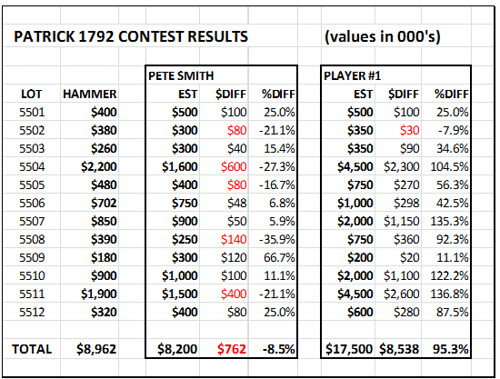
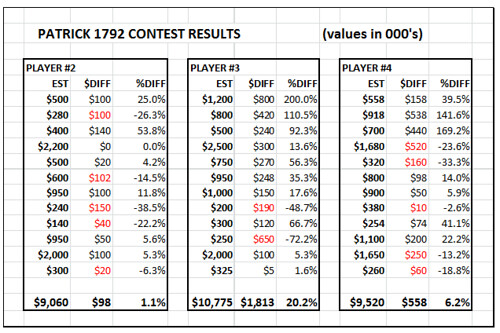
To read the earlier E-Sylum articles, see:
THE PARTRICK 1792 CHALLENGE (http://www.coinbooks.org/esylum_v17n53a14.html)
PARTRICK 1792 CHALLENGE UPDATE (www.coinbooks.org/esylum_v18n01a07.html)
THE BOOK BAZARRE
BOSTON TIME CAPSULE OPENED
This evening, the Commonwealth of Massachusetts and Museum of Fine Arts, Boston, opened a time capsule removed last month from below the Massachusetts State House. Governor Deval Patrick, Secretary of the Commonwealth William Galvin, and Malcolm Rogers, the MFA’s Ann and Graham Gund Director, watched as the contents of the time capsule, originally placed under the State House cornerstone by Governor Samuel Adams, patriot Paul Revere and Colonel William Scollay in 1795, were revealed.
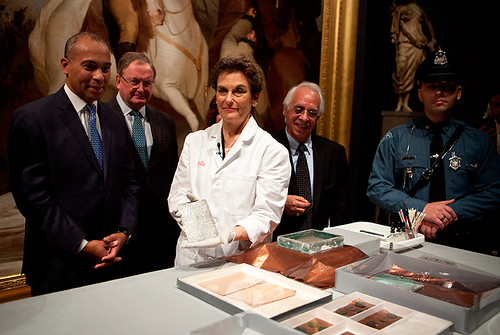
L-R: Massachusetts Governor Deval Patrick, Malcolm Rogers, Director of the Museum of Fine Arts, Boston, Pam Hatchfield, Head of Objects Conservation at the Museum of Fine Arts, Boston, and B.J. Mohammadipour display a silver plaque inscribed by Paul Revere, after the unveiling of the contents of a 1795 time capsule, at the Museum of Fine Arts on January 6, 2015, in Boston, Massachusetts.
To read the complete article, see:
Museum of Fine
Arts, Boston opens 'oldest' United States time capsule from 1795
(http://artdaily.com/news/75564/Museum-of-Fine-Arts--Boston-opens--oldest--United-States-time-capsule-from-1795#.VLHcfCsVhYE)
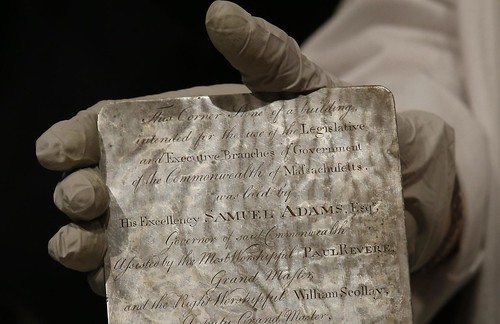
Using a porcupine’s quill, several small pieces of paper, a strip of polyester film, and a small metal pick that resembled a dental tool, Museum of Fine Arts conservator Pam Hatchfield carefully plucked history from a box Tuesday night.
The box was a time capsule, many of its items first placed beneath the cornerstone of the Massachusetts State House 220 years ago to mark the start of the building’s construction. The history came in many forms.
There were five neatly folded newspapers, a collection of 23 coins dating as far back as 1652, a medal depicting George Washington, a replica of Colonial records, and a silver plate commemorating the erection of the new State House.
To read the complete article, see:
Coins,
newspapers found as time capsule is opened
(www.bostonglobe.com/metro/2015/01/06/massachusetts-state-house-time-capsule-one-nation-oldest-opened/sGPawnxgHqoUnufy9I4PCJ/story.html)
The opening of the capsule revealed the following items inserted in 1795:
- Pine tree shilling, dated 1652
- U.S. half dollar, dated 1795
- U.S. half dime, dated 1795 (these three made of silver)
- Massachusetts cent, dated 1787
- Massachusetts cent, dated 1788
- Washington medal, dated c. 1783
- New Jersey cent, dated 1787
- U.S. cent, dated 1793
- U.S. cent, dated 1794
- A 4.2-inch by 5.5 inch silver plate.
The time capsule was first placed in 1795 during a dedication ceremony for the State House's groundbreaking. A ceremony was conducted by Paul Revere, Grand Master of the Freemason Grand Lodge of Massachusetts, at the invitation of Governor Sam Adams, both noted Revolutionary era patriots, along with William Scollay.
In 1855, maintenance and expansion to the State House revealed the time capsule which was subsequently extracted. The items were removed, documented cleaned and reinterred with the addition of new items.
The 1855 items include:
- One silver U.S. half dollar, dated 1855
- One silver U.S. quarter dollar, dated 1855
- One U.S. dime, dated 1855
- One U.S. three cent coin, dated 1855
- Four copper U.S. one cent coins – one each from 185, 1853, 1854, 1855
- Three U.S. half cent coins – one each from 1851, 1853 and 1854
- One title page for The Records of The Governor and Company of the Massachusetts in New England, printed by the order of the legislature and edited by Nathaniel Shurtleff, M.D. One impression of the Massachusetts State Seal in use in 1855 Cards by G.J.F Bryant, Architect, and J.R. Richard Architect Assorted morning papers of the day
As Hatchfield removed the newspapers, she commented on how well preserved they were with little corrosion. Some of the coins, though, were damaged by acid intended to preserve them over time.
The silver plate thought to be engraved by Revere, a silversmith by trade, depicting his name as well as that of Adams and Scollay, was engraved again to include the name of Governor Henry J. Gardner.
It still had fingerprints on it upon removal.
To read the complete article, see:
Here's What Was Stashed Away in the
1795 Time Capsule (http://bostinno.streetwise.co/2015/01/06/items-contents-of-mass-state-house-1795-time-capsule-2/)


To read the complete article, see:
So, What Was In That
Boston Time Capsule? (www.slate.com/blogs/the_vault/2015/01/06/history_of_time
_capsules_boston_statehouse_time_capsule_opening.html)
To read the earlier E-Sylum article, see:
1795 MASSACHUSETTS STATE HOUSE TIME CAPSULE
(www.coinbooks.org/esylum_v17n51a12.html)
NOTES FROM E-SYLUM READERS: JANUARY 11, 2015
More on the Numismatic Scrapbook Contributor's Medal
Tom DeLorey writes:
The Numismatic Scrapbook Contributor's Medal was struck for Lee Hewitt by the Osborne Register Co. of Cincinnati. They cut one reverse die for him, and paired it with stock dies for the first five presidents from one of their sets.
I found this out when I was working for Coin World and found an example of the Washington piece in a junk box at a coin show. I wrote to him asking about it, and he replied with the above information and sent me three different of the other four. He apologized for being out of the other one. This was sometime in the mid-1970's.
To read the earlier E-Sylum article, see:
THE NUMISMATIC SCRAPBOOK CONTRIBUTOR MEDAL (www.coinbooks.org/esylum_v18n01a13.html)
More on the Big Ben Coin Design
Jeff Starck of Coin World writes:
 Regarding the design elements accompanying the Big Ben L100 coin just issued by the Royal Mint: I believe those are trees. As you noted, the coin
gives a wonderful perspective of a tourist looking up at the clock The designers are Royal Mint engravers Glyn Davies and Laura Clancy. Coin World
reported about this on Dec. 29.
Regarding the design elements accompanying the Big Ben L100 coin just issued by the Royal Mint: I believe those are trees. As you noted, the coin
gives a wonderful perspective of a tourist looking up at the clock The designers are Royal Mint engravers Glyn Davies and Laura Clancy. Coin World
reported about this on Dec. 29.
Here is some flowery language from the Royal Mint website:
“In this magnificent portrait by Royal Mint engravers Glyn Davies and Laura Clancy you’re transported to street level, gazing upwards from the ground at this architectural marvel with the wide-eyed thrill of a tourist jostling for a view. Looking at the tower from this perspective you strip away the familiarity: there’s a freshness, a new found sense of wonder at this magnificent building and all that is represents. Surely even the most jaded Londoner couldn’t help but be impressed, and remember the very first time they saw this incredible sight.”
The coin is indeed proving popular, as the Royal Mint has begun limiting purchases to 10 per person and pushed delivery back to mid-February at the earliest.
To read the Coin World article, see:
Big Ben dominates first-ever £100-for-£100 coin
from Royal Mint (www.coinworld.com/news/royal-mint-announces-first-p100-for-p100-silver-coin.html)
To read the Royal Mint article, see:
Chimes of History
(www.royalmint.com/shop/Big_Ben_2015_UK_100_pound_Fine_Silver_Coin)
To read the earlier E-Sylum article, see:
ROYAL MINT MAKES BIG BEN £100 COIN (www.coinbooks.org/esylum_v18n01a19.html)
Query: Arizona Territorial Centennial Medal Mintage Sought
 Jan Monroe (maent65@gmail.com ) writes:
Jan Monroe (maent65@gmail.com ) writes:
I am looking for mintage figures for the Arizona Territorial Centennial Medal. The medal was struck in copper, bronze, gilt, silver, gold and platinum. If anyone can point me to a source for this information I would appreciate it.
Query: Schulman Gibbs Sale Catalog Sought
Dick Hanscom writes:
For a new project, I need some help. I have photocopies of a Schulman auction with the H.D. Gibbs primitive monies, only the pages that relate to Alaska.
What I am seeking is:
1) the date of this auction
2) a good scan of Mr Gibbs holding a “Tinnah”, lot 648 from the plates. This does not appear to be lot 648, but the photo will serve my purposes. My photocopy is not good enough to scan.
Thanks very much.
Query: Truman Congressional Gold Medal Images Sought
Greg Ruby writes:
My attempts to find any information on the Truman Congressional Gold Medal have produced no results. There is a UPI picture of Reagan presenting the medal to Margaret Truman, but the medal detail cannot be discerned.
Acting Press Secretary Larry Speakes banned news media from the ceremony at first, but later relented for print media and still photographers. Ideally, would love to get pictures of the medal design. Any additional information is a bonus. Many thanks!
Sally Kirka and Sheldon's Somotypes
Dick Johnson writes:
In addition to the biographical items in last week's E-Sylum, Sally Kirka was also an officer in the Hartford Coin Club, and general manager of at least two NENA conventions in Hartford. These were all well run attesting to her management.
She was a heavy-set lady and her husband was tall and thin. The pair were the personification of Mutt and Jeff. Or on Doctor Sheldon's somotype scale the extremes of endomorph and ectomorph. I guess it's true opposites attract. We've discussed Doctor Sheldon's scale before in The E-Sylum (vol 11, no 49, article 10).
Sally would attend the national ANA conventions. But I never saw her on the bourse floor. No floor dealer had elongated cents or wooden nickels. So she sat in the hotel lobby for the three or four days of the convention then return home. I quess she could tell her club members she attended the ANA convention.
To read the earlier E-Sylum articles, see:
ELONGATED COIN COLLECTOR SALLY KIRKA (www.coinbooks.org/esylum_v18n01a18.html)
DICK JOHNSON: I NEVER MADE SHELDON'S BOOK, BUT I WAS SOMOTYPED
(www.coinbooks.org/esylum_v11n49a10.html)
SUPERIOR PHOTO OF O-130 1795 HALF DOLLAR SOUGHT
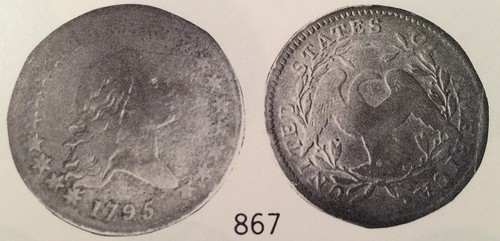
The International Bank Note Society, Vancouver chapter, hosted a “white elephant” fund-raiser sale at their Christmas party and I picked up some lots of old auction catalogs. Looking through them, the description of Lot 867 caught my attention. It said:
1795. Overton 130; 7 berries left, 10 right; O first cut sideways, then corrected. Very Good, a few details more like Fine; right half of obverse rough, probably from sea water, as the left part (which we may suppose to have been protected by another coin) is entirely normal. Reverse is clean, evenly worn, without any defects worth mention. Listed as R-6, but evidently near the top of that level; so rare that Overton never illustrated one, its reverse (U) being one of only five reverses of 1795 (reverses A, D, P and Q being the others) not pictured in any combination. Important enough as such, we believe, so that extra photos of this coin will be furnished on request, at nominal cost, to bidders wishing to insert them into their copies of Overton’s book. PHOTO
from Superior Stamp and Coin Co., Inc. Auction Sale - Part 3 October 1, 2, 3, 4 1973 (Clarke E. Gilhousen collection)
 My second edition of Overton (1970) did not have this photo added. Does anyone have a copy that
does? I haven’t checked to see if Superior still has extra photos available…
My second edition of Overton (1970) did not have this photo added. Does anyone have a copy that
does? I haven’t checked to see if Superior still has extra photos available…
The 1795 O-130 is now considered an R-5 and later editions include illustrations, but I am still impressed with the generosity of the original
offer to share numismatic information.

MORE SMALL COINS
Indian Gold Fanams
Kavan Ratnatunga writes:
Talking of small coins, the smallest in my collection is the 5.8 mm Indian gold Fanam. Unlike the other Indian gold fanams with geometric designs the detail on this tiny elephant coin is amazing for its size.
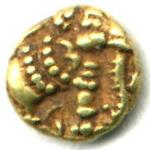
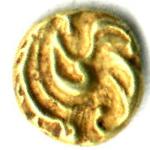
To read the complete article, see:
India - 1200-1400 - Western Gangas : Gold Gajapati Fanam
(http://coins.lakdiva.org/medievalindian/gajapati_fanam_au.html)
Medieval Russian Coins
I saw the E-Sylum entry about tiny coins and most notably the mention of the tiny silver coins from medieval Russia. Before I was seduced by the joys of exonumia I specialized in early Russian coins and built up a decent collection of the things which I still have. Some of the feudal era coins prior to Ivan the Great and Ivan the Terrible were amazingly small and included not only the more familiar denga (half kopeck) but also half denga (polushka) and quarter denga (chetveretsa) that are positively microscopic.
Here is a small selection of medieval Russian coins compared to a three-cent silver piece for comparison's sake. From left to right, the coins are:
Principality of Novgorod
AR Chetveretsa; no date (c. 1420-1478); no mint name; 0.10 g.; 6.8 x 9.2 mm; Gaidukov 106, Oreshnikov 51 (pl. I, 12), Spassky fig. 66-7 This is the smallest coin in my entire collection and is paper thin.
Principality of Tver
Æ Pulo; no date (c. 1500); no mint name; 0.35 g.; 11.2 x 8.8 mm; Gaidukov 361
Ivan IV "the Terrible" as Tsar
AR Kopeck; no date (1547-1584); Novgorod; 0.62 g.; 16.0 x 12.3 mm; Melnikova 22-26, KG 80
This coin is dramatically double struck with two clear strikes; ex: Montgomery Blair. Montgomery Blair was Lincoln's Postmaster General and he had a small group of these, almost all of which were from Ivan IV's reign. I got a few of these pieces from Gene Brandenburg when I worked for him back in the day...
AR Denga; no date (1547); Tver; 0.35 g.; 9.2 x 12.0 mm; Melnikova 18-22, KG 72
AR Polushka; no date (1535-1584); Moscow; 0.15 g.; 8.9 x 7.6 mm; Gaidukov 372/384, KG 98, Spassky 79-9
Peter I "the Great" as sole Tsar
AR Kopeck; C? (Orthodox Era 7207/1699 CE); “Old Mint” (Moscow); 0.28 g.; 11.7 x 7.5 mm; KG (Peter) tab. 8, 7/tab. 4, 8 The dies for these are far
larger than the planchets and the majority of them do not show the date as a result. I have a small selection of dates, to include some from his
joint reign with Ioann V as well as from later in his reign before the silver "wire" kopeck was finally abolished.
Some day I would love to put that Novgorod chetveretsa on a Swedish copper plate 8 daler piece.
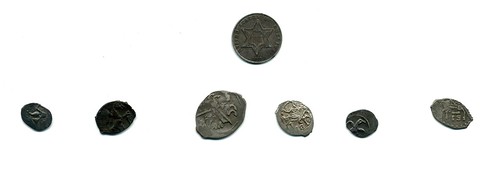
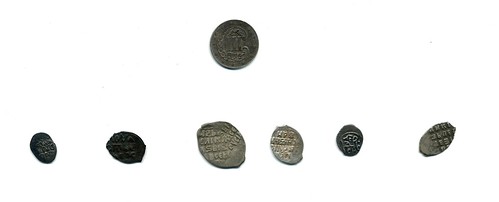
Thai Bullet Coins

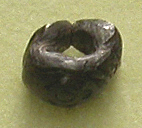

In addition to owning the large uncut sheets of French assignats I wrote about last week, I also own numerous exceptionally small world coins from the last few centuries. In 2005 I showed a few dozen of them in an exhibit, and a local artist created an art book using my graphics and text. The lightest coin I had weighed .04 grams. It was (and still is) a very thin uniface gold Nepal dam from 1847-81. It isn't perfectly round. The maximum diameter is 6.94 mm. But diameter-wise, that coin dwarfed a possible Thai silver "bullet" coin I owned for half of 2007.
It's a sad & embarrassing but funny tale. Kent Ponterio photographed the coin for me, to show Scott Semans, who I approached to learn what I could about it. Its previous owner catalogued it as a 1/128 baht. It bore a crude chakra. I measured it as about 2-3 mm. diameter, and it weighed just under .05 grams. Scott concluded that it was probably a piece made by an "upcountry" Thai hill tribe, not an official national issue. He pointed out that a 1/128 baht should have weighed .12 grams. Both Charles Opitz's An Ethnographic Study of Traditional Money and the Standard Catalog of World Coins listing are entirely consistent with all of this.
The sad & embarrassing part? I spent New Year's Eve 2007-8 working up coins which had accumulated on my desk during the past year. I had the Thai piece out of its 2x2, laying on the clean towel where I lay raw coins before I package them. The last thing I did after I finished up with everything else, was to notice that there was some residual crud on the towel. (You can guess the rest.) I took the towel outside on my 2nd story patio and shook it out aggressively over the balcony, then tossed it back on my desk before hitting the sack.
Next morning I realized what that dirt must have been. I spent fruitless hours searching my patio and the mulched plants in the courtyard below. Maybe it's still down there, a few inches below the surface. At least I still have the close-up photos and measurements. And I have a replacement tiny fractional baht bullet money piece in my collection now, weighing in at .19 grams, with slightly below 4 mm. max diameter. I'm NOT going to take it out of its 2x2 to measure it better or photograph it. Understand, it's anything but flat - it's closer to a tiny thick doughnut; almost a ball.
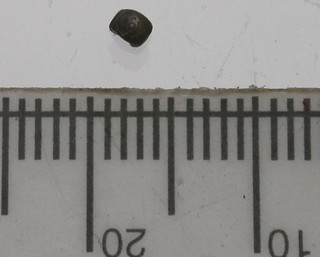
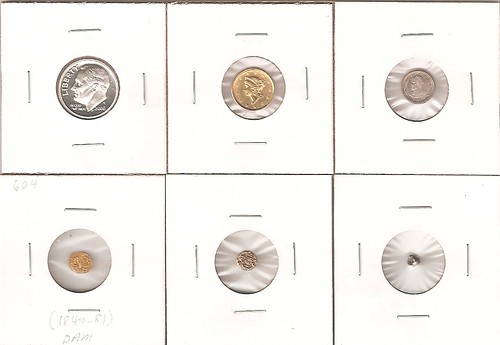
First, for comparison purposes, is a U.S. dime (17.9 mm.). Next, the smallest regular U.S. issue, being the first series Liberty Head gold dollar. At 12.7 mm. diameter, it was smaller than the smallest half dimes (15.5 mm.) and 3 cent silvers (14 mm.). Next is a 1904 Panama 2-1/2 centavo "pill," which Mr. Johnson cited (10.23 mm.). Next is my thin uniface gold Nepal dam (6.94 mm., .04 gram). Next is a gold fanam (=1/2 anna, ordinarily a copper coin) from Mysore State, India, 1799-1810, 5.94 mm. It depicts a facing man-lion incarnation of the Hindu god Vishnu. Can you see that? Finally, my replacement smallest Thai bullet coin (.19 gram, but less than 4 mm.). As I learned the hard way, these are easy to lose!
Minimissimi
The smallest pieces (mentioned in the item in The E-Sylum of 5th January) appear to be:
- Indian gold fanams, silver chuckrams and copper cash, 6-7mm (but some below 5mm);
- 5th century minims / minimi, often 9-11mm (David proposing AE5 = for 9-13mm).
There is, however, no mention of the "minimissimi", which appear to be 5th/6th century barbarous copies of Roman coins, apparently ranging in diameter from about 5mm down to 2mm(!) Although at first thought of as actual coins, these were apparently used as votive pieces, so maybe would now be categorised under paranumismatica.
For example, see p.11 of FROCESTER - A Romano-British Settlement its Antecedents and Successors Eddie Price VOLUME 2 THE FINDS
Published 2000 by Gloucester and District Archaeological Research Group
"There are 16 in the Frocester series less than 8mm in diameter, including one of 4mm, one of 2½mm, and one of 2mm (no 156)." and The Ending of Roman Britain By A.S. Esmonde-Cleary 2002 p.76: "Another site which has yielded coins which may be linked with religious observance was the great fourth-century temple-complex at Lydney [193] on the north side of the Severn estuary. There were found large numbers of tiny, bronze coins (minimissimi — fifty to cover an old halfpenny or modern twopenny piece) copying mid-fourth-century prototypes. These were far too small to be of any practical use, and their presence on a temple site may suggest that they had some token, votive use."
To read the complete item, see:
FROCESTER - A Romano-British Settlement its Antecedents and Successors
(www.glosarch.org.uk/vol2.pdf)
* A.S. Esmonde-Cleary, The Ending of Roman Britain (2002), p.76: "Another site which has yielded coins which may be linked with religious observance was the great fourth-century temple-complex at Lydney [193] on the north side of the Severn estuary. There were found large numbers of tiny, bronze coins (minimissimi — fifty to cover an old halfpenny or modern twopenny piece) copying mid-fourth-century prototypes. These were far too small to be of any practical use, and their presence on a temple site may suggest that they had some token, votive use."
* In the item on "Monim or Minimos" in "The teach yourself guide to numismatics : an A B C of coins and coin collecting" (1956-1970 - titles vary), Christopher Churchill Chamberlain says: "Some of these are no bigger than the head of a pin; in fact, more than fifty of such minimissimi (smallest minimi) would be needed to cover a modern halfpenny. In 1929 a hoard of many hundreds of these coins was found at Lydney Park, Gloucester."
[IF the authors meant that the halfpenny (25.4mm) or twopence (25.9mm) had 50 times the area of such minimissimi, this would give an effective diameter of 3.6 to 3.7mm.]
* Philip Kiernan, Miniature votive offerings in the north-west provinces of the Roman Empire (2009), p.163:
"5.5 The 'minimissimi.' In 1929, a hoard of 1,646 bronze coins was found underneath a mosaic floor in the bath-house at Lydney Park. Some of these coins, termed minimissimi by Wheeler, had an average diameter of 2.75 mm, and an average weight of 0.057g. All were crude copies of Roman bronze coins with the legend FEL TEMP REPARATIO that were struck in the middle of the fourth century A.D. but ..."
* John H. Humphrey, Journal of Roman Archaeology: Supplementary series - 1999 - Architecture, p.31:
"An exception may be the substantial numbers of tiny late Roman coins (so-called minimissimi) at Lydney Park (Glos.), which were possibly the result of unofficial production for ritual purposes."
Items Made With Travancore Silver Coins
Philip Mernick writes:
I don’t know what the inhabitants of Travancore thought of their tiny silver coins but the local silversmiths liked them. They fashioned them into all sorts of items for the breakfast table and my brother Harry has many examples in his ornamental money collection. Some are made from several hundred coins. I have to assume that they were made for the British residents shortly before independence.

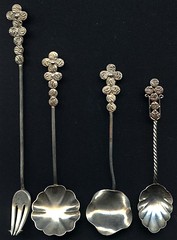
Cake stand and silverware


Menu holder and dish
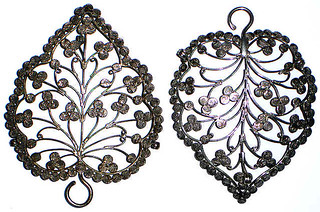
Cake stand
To read the earlier E-Sylum article, see:
NUMISMATIC ITEMS, SMALL AND LARGE (www.coinbooks.org/esylum_v18n01a08.html)
MORE ON BERT COHEN AND MACERATED CURRENCY
Tom Elder's Macerated Currency Paperweights
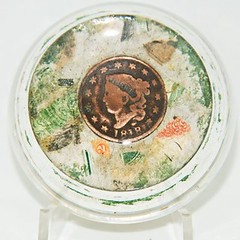
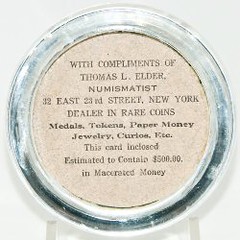
Tom DeLorey writes:
I used to own one of those Thomas L. Elder paperweights with the macerated money in it. As I recall, the surface that was pressed up against the glass was covered with various fragments cut or torn from common obsolete bank notes and glued onto the macerated plug to make it more interesting
Bert Cohen's eBay Business
Ken Barr writes:
Regarding Pete Smith's inquiry, it appears that someone is continuing Bert Cohen's business after his death, as both his website (www.marblebert.biz) and his eBay account (marblebertbertram) are still active, the latter having received positive feedback for a sale within the past month.
Bert was universally acknowledged as having the best collection of macerated currency by far, with Ruth Bauer (the late Harry J. Forman's partner) probably a distant second. I had corresponded with Bert twenty or so years ago on the subject, and hoped that one day he would document his collection in a book or pamphlet, but no such luck. Macerated currency collectibles were produced between about 1874 and 1920, pressed into postcards, busts, monuments, medals, shoes, hats, etc. A quick search on eBay using "macerated" as a search term will show numerous examples, many from Bert's account.
To read the earlier E-Sylum article, see:
NOTES FROM E-SYLUM READERS: JANUARY 4, 2015 : More On Bert Cohen
(www.coinbooks.org/esylum_v18n01a09.html)
REMEMBERING OSCAR PEARL
Regarding Oscar Pearl, Dave Bowers writes:
One day in the 1970s a gentleman came to my office, then in Los Angeles, and introduced himself as Oscar Pearl. I asked if he was the Oscar Pearl whose collection of large copper cents was offered at fixed prices by Numismatic Gallery (Abe Kosoff and Abner Kreisberg) in 1944. He verified that he was one in the same. We chatted about his earlier involvement.
Oscar began his career in New York as a banker, then went to work for Burroughs, a maker of business equipment, after which he set up a successful dealership in used equipment. After selling his cents he continued to collect, but quietly. He moved to Italy where he became involved in some sort of situation in which he preferred anonymity for his own safety. By the 1970s that had cleared, he was back in the United States, and all was well. He consigned coins to us which we sold at auction. I do not recall hearing from him after that. No doubt he contacted some others as well, who may have information today.
Harvey Stack writes:
I met Oscar Pearl in the office in New York during my apprenticeship. Though he sold his collection through Numismatic Galleries (Kosoff and Kriesberg) he always had interest in Large Cents. He would meet Dr. Wiiliam Sheldon occasionally at Stack's, discuss the copper coins, and I believe he contributed to Early American Cents by Sheldon, did work for the Society as a researcher, but I do not remember him much after that. The name was legendary in Large Cents and I do remember people like Bareford, Doug Smith, Louis Werner and others of that period who considered him as a source of information for their collections.
To read the earlier E-Sylum article, see:
OSCAR PEARL AND ABE KOSOFF (www.coinbooks.org/esylum_v18n01a16.html)

THE 1863 ALUMINUM POSTAGE CURRENCY PATTERNS
In last week's E-Sylum, David Lange wrote:
“To the best of my knowledge, the complete aluminum proof sets of 1868 are the earliest aluminum pieces confirmed as being contemporary with the date they carry, and all earlier-dated pieces are subject to being restrikes or novodels.”
 I have no information on US pattern coins struck prior to 1863. What I do have is proof that in May
and June of 1863, a few aluminum pattern Postage Currency coins were struck. The dates of striking and the quantities were well documented. As to
dating the striking of these coins, May 19, 1863, S.H. Chapman & H. Chapman in the George Eavenson Collection were documented from the Mint
Director Chase’s “Mint Report of 1863.” Usppcc pg. 121
I have no information on US pattern coins struck prior to 1863. What I do have is proof that in May
and June of 1863, a few aluminum pattern Postage Currency coins were struck. The dates of striking and the quantities were well documented. As to
dating the striking of these coins, May 19, 1863, S.H. Chapman & H. Chapman in the George Eavenson Collection were documented from the Mint
Director Chase’s “Mint Report of 1863.” Usppcc pg. 121
Plate 8, page 142 of my book “United States Pattern Postage Currency Coins” (published 2007) pictures the original wrappers containing the information in the handwriting of Mint Assayer, William E. DuBois presented to Mint Director, James Pollock, and then to Salmon P. Chase, Secretary of the U. S. Treasury during the administration of President Abraham Lincoln. “No. 3 Aluminum 2 pieces. 10 cts each weight 8 grains, value about 5 cents, each.”
The ten coins pictured on five wrappers were discovered in the early 1960s hidden in a time capsule that was discovered when a Dallas bank was remodeled. Milton R. Friedberg bought the coins and wrappers and later sold them at auction. Quoting:
"No. 1 Two pieces Standard Silver, 20 grains, value 5.21 cents
No. 2 Two pieces Standard Silver, 22 grains, value 5.73 cents
No. 3 Two pieces Aluminum, weight 8 grains, value about 5 cents each
No. 4 Three pieces Block (pure) Tin, weight 21 grains, value 1/6th of a cent each
No. 5 One piece Block tin, weight 27 grains, value 1/5th of a cent"
The first recorded sale of these aluminum coins was by Ed Cogan who catalogued the sale on June 29-30, 1864, Lot 758, Aluminum.
On October 16 thru 20, 1865, Ed Cogan sold Lot 2057 as an Aluminum coin. Although unpictured, the written description of these coins is that of a Postage Currency ten cent coin.
To read the earlier E-Sylum article, see:
WHEN ALUMINUM COINS WERE STRUCK (www.coinbooks.org/esylum_v18n01a12.html)
DAVID J. MALLOY'S CUSTOM COIN BOARDS
In an email December 30, 2014 distributing the latest issues of his Coin Board News and Coin Boards for Sale, David Lange wrote:

Another neat little item is a 1931 photograph of murderess Winnie Ruth Judd which happens to include David J. Malloy at far right. He commissioned his own coin boards from Lincoln Printing Company in 1939, and this is the first photo of him known to me.
The photo of Malloy included with my newsletter is the only portrait known to me. I'm attaching images of the coin board he commissioned from Lincoln Printing Company to promote his Los Angeles funeral home in 1939. It's extremely rare, and I know of only three examples, two of which are in my own collection.

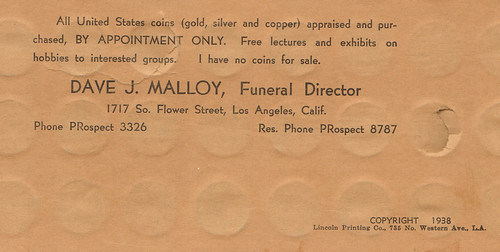
David W. Lange
POB 110022
Lakewood Ranch, FL 34211
941-586-8670
http://coincollectingboards.com
For more information on Winnie Ruth Judd, see:
Winnie Ruth Judd (http://en.wikipedia.org/wiki/Winnie_Ruth_Judd)
CREMATORIUM IDENTIFICATION TAGS
Crematorium Identification Tags - A Brief Introduction
by Heather Schena
Crematorium identification tags appear in some collections and online sales described as "tokens" (implying there is some sort of numismatic function). This is understandable since most people do not often see these tags and they have some characteristics in common with tokens. A brief introduction to the appearance and use of these metal tags will educate collectors so they may identify these pieces more readily.
The cremation tag in the United States has relatively short history. Jason Engler, Historian for the Cremation Association of North America, states:
The crematory token was first invented in the 1930s by a very ingenious cremationist named Lawrence Moore, who was indeed the preeminent crematory and columbarium operator in the country - his Chapel of the Chimes in Oakland, Calif., was the busiest and most successful stand-alone crematory on the continent. The system of positively identifying cremated remains by way of indestructible identification was originally effected with a fireclay tablet. Later, stainless steel tags were created and there are now very few crematories in operation that do not use this system.
These tags are used to identify the deceased throughout the cremation process. As seen in the example below, there is a serial number on the tag (2989 in this case) which is written on the paperwork associated with a particular decedent. It is placed inside the door of the retort (cremation oven) during cremation; this is why it looks so worn - it's been exposed to temperatures at 1600°F+. The tag stays with the ashes (cremains) afterwards and is included in the urn when the ashes are handed over to the family. It is either tied to the bag with a twist tie or is dropped into the bag with the ashes. When the cremains are returned to the family they are usually in a temporary container; when they are transferred to a permanent container or if the ashes are scattered the tag can be easily separated from them.
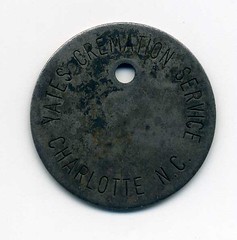

To identify this specific example, I found a listing for "Yates Wilburt Vault Co." in Charlotte and called them to see if they were affiliated with the company on the medal only to learn that it was the same company. Yates Cremation Service has contracts with other funeral homes to do their cremations (so a funeral home can offer the service without having to build their own crematorium). This also explains why it was not listed by itself when I did a Google search. They were able to tell me that the date of death for this specific decedent was in 1991. Dan Yates, president of the company, told me that it is no longer their policy to put the name of the company on the tags since (at least in theory) it could be traced back to a specific person, so it will be close to impossible to track down a date or location for these tags in the future.
It is worth noting that should a collector find a tag with the name of a funeral home and a serial number, it could be traced back to a specific individual and discretion should be used in determining how vigorously additional information is pursued.
The tag blanks I have found for sale are usually stainless steel (brass and titanium are rarer options) with the name of the crematory and the serial numbers engraved by the manufacturer. Stainless steel is ideal since it withstands high temperatures. Higher nickel and chromium contents also mean that many of these tags are not magnetic, though they are still considered stainless steel. Below is an example of a tag prior to exposure to crematorium temperatures; comparing it with the previous example gives some indication as to the stresses endured by the tag.

While these tags are not numismatic in nature, knowing about them and their purpose will assist collectors who may run across one of them in their travels. However, there are a few collectors of these tags who appreciate the importance of their use, and by educating the greater collecting public about them this appreciation can grow.
Yates tag photos courtesy of Eric Schena
Tulsa, OK tag photo courtesy of Mr. Jason Engler
For more information on the Token and Medal Society, see:
www.tokenandmedal.org/
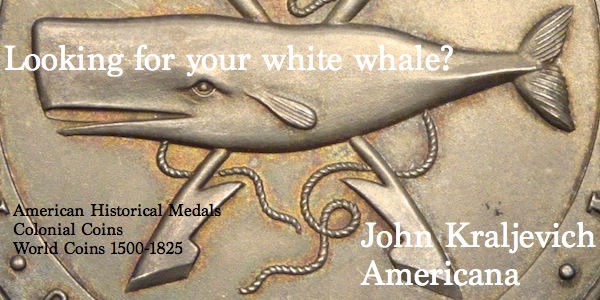
Q. DAVID BOWERS AND NUMISMATIC WRITING
Q. David Bowers, Hard Times Tokens, and the Art of Numismatic Writing
by Dennis Tucker, Whitman Publishing
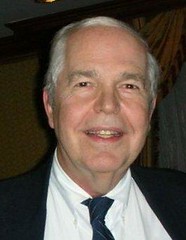 If you’re a
longtime coin collector, as I am, you’ve probably read quite a few works by Q. David Bowers. After all, he’s been writing in the field of numismatics
since the 1950s, he published his first book (Coins and Collectors) in 1964, his list of titles has surpassed four dozen, and his articles and
columns number in the thousands. Yes, the thousands. Dave’s scope ranges from American colonial coins to modern-day Proofs, from ten-cent tokens to
ten-million-dollar rarities.
If you’re a
longtime coin collector, as I am, you’ve probably read quite a few works by Q. David Bowers. After all, he’s been writing in the field of numismatics
since the 1950s, he published his first book (Coins and Collectors) in 1964, his list of titles has surpassed four dozen, and his articles and
columns number in the thousands. Yes, the thousands. Dave’s scope ranges from American colonial coins to modern-day Proofs, from ten-cent tokens to
ten-million-dollar rarities.
On top of that his prose is featured in various parts of the Guide Book of United States Coins (the hobby’s best-selling “Red Book,” with more than 23 million copies in print since 1946). So if you’ve been collecting coins, tokens, medals, or paper money for more than a year or two and you’ve never read a word of Bowers, I have good news and bad news. The good news is you’re rarer than an 1804 dollar! The bad news is you’re missing out on a full and complete hobby experience. Fortunately the solution is never far away, thanks to your local bookstore, the library, and the Internet.
I spoke with Mr. Q. David Bowers for the first time soon after I joined Whitman Publishing in December 2004. I was in the company’s Atlanta headquarters and Dave was in Wolfeboro, New Hampshire, where he does most of his writing. At the time he was already Whitman’s numismatic director. I had grown up, numismatically speaking, reading Bowers books and articles, so it was quite an honor for this recently minted numismatic publisher to be speaking with a legend as a colleague. “Call me Dave,” he said. “Everybody does. If you insist on calling me ‘Mr. Bowers’ I’ll call you ‘Mr. Tucker’!”
Dave and I have talked or emailed nearly every day since that first phone call. Over these ten years we’ve worked on books ranging from 96-page monographs to 900-page encyclopedias. His productivity is amazing. One of the most frequent questions I hear from collectors is, “How does Dave Bowers write so many books?” The process is remarkable to observe.
First of all, you need to know that he’s been writing for more than 50 years. Perhaps writing isn’t the best word; it’s too constrictive, too narrow. Producing? Creating? What Dave does is multi-faceted and immersive, more long-range than the simple physical act of sitting down at a desk and putting pen to paper (to use an old-fashioned expression).
The bedrock of his system is the Bowers archives. Long before the Internet, Dave was compiling a personal library and research center of books, newspapers, magazine clippings and snippets, and other resources—anything and everything numismatic. He read and studied decades’ worth of old periodicals the likes of Frank Leslie’s Illustrated Newspaper, and made note of everything relating to American coins, tokens, paper money, general and specific economic conditions, the intricacies of day-to-day bank operations, interesting financial-sector goings-on, Mint procedures, Treasury gossip, and more. (Again, this exercise was before Google searches, online book archives, and other modern conveniences. It has developed, or least strengthened, what I suspect is a photographic memory combined with instant recall.)
Starting in the mid-1950s Dave began interviewing key figures in numismatics—B. Max Mehl, Abe Kosoff, Stephen Nagy, Robert Botsford, U.S. Mint directors from Rae Biester to date, and hundreds more, gaining knowledge that would have otherwise been lost forever. As technology has advanced, so has the Bowers research machine. Historical images that he earlier had to clip, photograph, or photocopy can now be scanned and saved digitally in high resolution. Instead of having to travel to faraway museums and archives, email and the Internet put him in a hundred places at once, with instant communications.
This brings up another important factor in how Dave Bowers works: collaboration. “To have a friend, you must be a friend,” as the proverb goes. Over a career spanning decades, Dave Bowers has built a reputation as a researcher who generously shares information instead of jealously guarding it. His network has grown strong from this. Today, when a numismatist gets an email or phone call saying, “This is Dave. I’m working on a new book about [fill in the blank], and was wondering if you have any images, die varieties, new research, or other information to share?” the answer is nearly always an enthusiastic “Yes!” He knows all of the museum curators, all of the Treasury and Mint officers, all of the historians, the collectors, the dealers, the auctioneers, researchers, archivists, and aficionados who make numismatics a vibrant and living American science. He goes out of his way to share his knowledge with them when they need help. In return they share their own specialized insight—and Dave absorbs and synthesizes it as only he can, to bring to his readers.
Another element of the Bowers method is a constant and never-resting spirit of inquiry that spans genres, disciplines, and fields. Dave is as curious a student of current Presidential dollars as he is of Massachusetts colonial silver and pre–Federal Reserve bank notes. He wrote a book on gold dollars minted from 1849 to 1889. He wrote another on State quarters that your kids can collect from pocket change today. Not to mention a massive study of pre-1916 American motion pictures . . . the definitive reference on automatic and coin-operated music machines . . . a monumental history of the California Gold Rush . . . an illustrated monograph on Art Nouveau artist Alphonse Mucha. . . . an exploration of the American bison in popular culture. His subjects run up and down the Dewey Decimal system. The breadth and depth of Dave’s intellectual curiosity and study bring to mind President John F. Kennedy’s famous quote at a 1962 gathering of Nobel Prize winners: “I think this is the most extraordinary collection of talent, of human knowledge, that has ever been gathered together at the White House, with the possible exception of when Thomas Jefferson dined alone.”
Add to these elements a genuinely engaging writing style; the ability to connect with and satisfy readers; a scientist’s ability to rigorously test theories and fearlessly question conventional wisdom; a technician’s grasp of information design and user interface; and an artist’s knack of seeing the whole before the parts are assembled.
All of these moving parts came together in the Guide Book of Hard Times Tokens, which will debut at the Whitman Baltimore Expo in March 2015. The foundation of Dave’s manuscript was the research he’d been gathering for many years: biographies of die engravers, histories of issuing firms, narratives about the political personalities involved; plus his observations on the market and collector activities, from several decades’ perspective; and images gathered over the course of his career.
He called upon friends and colleagues in the field: Steve Hayden volunteered his database of more than 18,000 public auction records and advised on retail pricing and rarity ratings; Evelyn Mishkin and others read early drafts to pick out typos and offer feedback; various collectors and dealers offered photographs to supplement Dave’s voluminous personal archive; historians at the American Numismatic Association, the American Numismatic Society, and other organizations pitched in as needed. At Whitman Publishing our design team planned the book’s look and feel, and our editorial staff worked with Dave to fine-tune the manuscript and marshal its million details. Over the course of several months this huge project was given its legs to stand on, and it took off running. As the Guide Book of Hard Times Tokens was under way, Dave was also actively working on manuscripts about obsolete paper money, Civil War tokens, 19th-century advertising shell cards, and several other topics. “I like to work on projects in parallel,” he always tells me. When he gets bored with one he’ll turn to another, which somehow charges his batteries so he can return to the first refreshed. A normal person would simply get tired, but the inimitable QDB is actually energized by work.
So there are some of my behind-the-scenes perspectives on the Dean of American Numismatics. When ambitious young writers ask me, “How can I become the next Q. David Bowers?” the answer is simple. All it takes is an insatiable curiosity about the world, a steel-trap mind, the ability to connect a hundred different disciplines logically and with panache, a vast network of friendly collaborators whose respect hasn’t been bought or beguiled but earned, an untiring work ethic, and 50 years of experience. Start early. The encouraging news is that if you accomplish even one-half of Bowers’s output, you’ll have earned a secure place in the numismatic history books.
Dennis Tucker
Publisher, Whitman Publishing, LLC
Atlanta, Georgia
STACK’S BOWERS TO TEAM WITH SOTHEBY’S


THE D. BRENT POGUE COLLECTION AND OTHER PROPERTIES
Stack’s Bowers Galleries and Sotheby’s are delighted to announce that they have entered into a multi-year agreement to jointly present a series of numismatic auctions at Sotheby’s global headquarters in New York City. The first of these auctions will take place May 19-20, 2015, highlighted by Part I of the D. Brent Pogue Collection — the most valuable collection of federal American coins in private hands — followed the next day by an exclusive sale featuring numismatic rarities from various owners.
“We are delighted to be working with the team at Sotheby’s to present the unrivaled D. Brent Pogue Collection as well as other properties,” said Greg Roberts, CEO of Stack’s Bowers Galleries. “As numismatists, we appreciate coins for their history and artistry and we fully expect these important numismatic sales to generate international interest, bringing a never before seen worldwide attention to the beauty, history and joy of numismatics.”
Stack’s Bowers Galleries continues their impressive legacy at the forefront of the rare coin field with over 80 years of expertise, including many of the most important rare coin collections ever to cross the auction block. Sotheby’s has been uniting collectors with world-class works of art since 1744, and today presents auctions in ten different salesrooms around the globe.
Sotheby’s and Stack’s Bowers Galleries have collaborated a number of times to bring iconic numismatic properties to auction, including the Dallas Bank Collection in 2001 and the $7.6 million auction of the legendary 1933 Double Eagle in 2002 that became the most expensive coin in the world.
“It is a pleasure to once again work with Stack’s Bowers Galleries. We anticipate a series of sales that will be major events in the numismatic world,” stated Maarten ten Holder, Sotheby’s Managing Director, Americas.
Stack’s Bowers Galleries and Sotheby’s will offer the extraordinary D. Brent Pogue Collection across a series of seven auctions. The Collection focuses on copper, silver, and gold coins from the early 1790s to the late 1830s, and includes some of the most important U.S. coins in existence, including the finest known Class I 1804 silver dollar – “The King of American Coins” – and the finest known and only example of the 1822 half eagle in private hands.
The D. Brent Pogue Collection and other numismatic rarities will be exhibited in Sotheby’s New York headquarters during Americana Week, from January 17–24, 2015, with other exhibitions to follow at Stack’s Bowers Galleries and Sotheby’s locations worldwide.
To visit the Stack's Bowers web site, see:
www.stacksbowers.com
To visit the Sotheby's web site, see:
www.sothebys.com
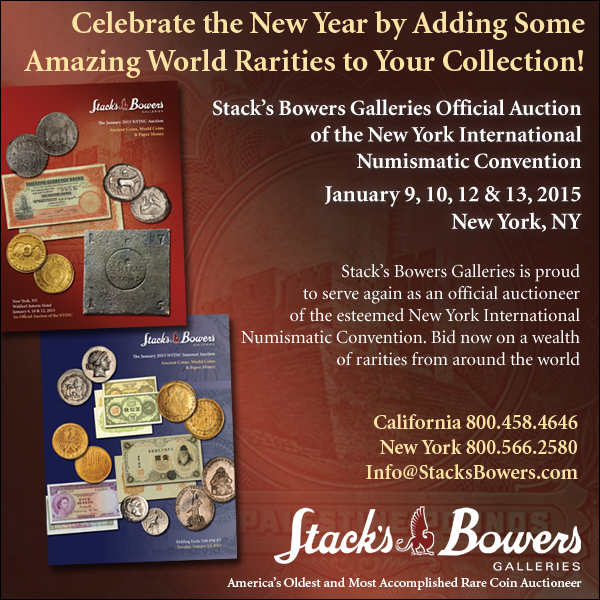
SOME INTERESTING MEDALS: JANUARY 11, 2015
McKENZIE’S THREE PUNTERS MEDALLION

SPECTACULAR GALVANO OF McKENZIE’S THREE PUNTERS MEDALLION, 1932-3. Kozar 97. 18” Cast Bronze. Robert Tait McKenzie, Sc.
Three nude athletes are shown in various stages of punting a football, At left center is McKenzie’s RTM monogram and below, FECIT/ 1932-3. At 6:00 a football lies on the ground between the feet of the two punters on the right. Incused in tiny letters on the rim below is “R. TAIT MCKENZIE 33”
The Three Punters relief was originally made 46” in diameter and was installed at the University of Pennsylvania, where it remains today, Almost immediately, Medallic Art Company reduced the image and produced a 76mm die from which it has struck both uniface medals and medals combined with his Joy of Effort die.
Robert Tait McKenzie is widely acknowledged as the foremost sculptor of athletes in the 20th century. The appearance of a large size relief such as this is an event worthy of note to even the most advanced collector. It may even be of equal interest to a benefactor who would like to gift his alma mater with a magnificent piece of art that would grace a school gymnasium for all to enjoy. $4900.00
1912 INTERNATIONAL NUMISMATIC CONGRESS MEDAL
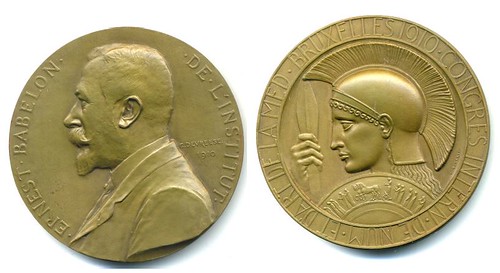
ERNEST BABELON - INTERNATIONAL NUMISMATIC CONGRESS MEDAL, 1912. Baxter 259; Willenz 112; Maier 52. 63mm. Bronze. Godefroid Devreese
(Obv.), Rudolph Bosselt (Rev.), Sc. Uncalculated, a few minor spots. Obverse: Bust of Babelon left, ERNEST BABELON DE L’INSTITUT around. Reverse: Head of Athena to left wearing a helmet with a large ornate crest. Her right hand grasps a spear near her head. A portion of the Panathenaic festival procession is shown on the upper edge of the circular shield which covers her shoulder. Legend: CONGRESS INTERN. DE NUM. ERT D’ART DE LA MED. BRUXELLES, 1910.
At the International Numismatic Congress in 1910 it was decided that a medal should be issued in honor of Babelon who had acted as President of the Congress. It was struck in 1912 under the joint auspices of the Societe Hollandaise-Belge des Amis de la Medaille d’Art and the American Numismatic Society. According to Miller the usually quoted mintage figures of 100 medals in silver and 200 in bronze relates only to the medals that were struck for the ANS. If one adds in the medals struck for the Societe Hollandaise-Belge, the totals are 156 in silver and 505 in bronze. $160.00
POLO PONY MEDAL

HORSE ASSOCIATION OF AMERICA POLO PONY MEDAL, 1928. 75.9mm. Bronze. Laura Gardin Fraser, Sc. Edge marked “Medallic Art Co. N.Y.” About Uncirculated.
The obverse portrays a polo player riding his pony in full stride to the right. The reverse bears the legend: HORSE ASSOCIATION OF AMERICA MEDAL. FOR THE BEST PLAYING POLO PONY ON EACH CLUB/ AWARDED TO. A wreath encloses the central engraved inscription: SNAPPER/ OWNER/ ROBERT W.POMEROY, JR./ CLVB/ GREENWICH POLO CLVB/ SEASON/ 1928
Mrs. Fraser’s interest in animals, particularly horses, is evident in this spirited medal which was first struck in 1923 $295.00
SAINT LOUIS WORLD’S FAIR “SILVER” MEDAL
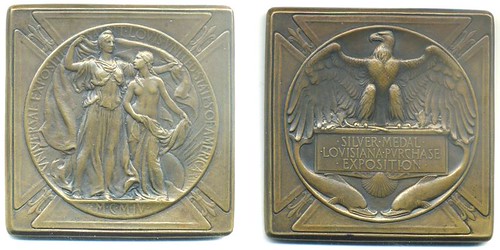
SAINT LOUIS WORLD’S FAIR “SILVER” MEDAL, 1904. Hendershot 30-50; Baxter 108; Krueger 14; Eglit LPE-6. 67x67mm. Bronze. Adolph A. Weinman, Sc.. (U.S. Mint). Nice About Uncirculated.
Obverse with a central medallion of Liberty cloaking herself and a young female figure next to her in the American flag.
Baxter finds in this an important precedent for Weinman’s “Walking Liberty” half dollar coin. The field on the reverse is filled by an American eagle with outstretched wings framing a cartouche for the inscription SILVER MEDAL/ LOVISIANA PVRCHASE/ EXPOSITION with a pair of opposed dolphins flanking a scallop shell below. $165.00
SWISS-FRENCH LINCOLN MEDALLION

MAGNIFICENT SWISS-FRENCH LINCOLN MEDALLION, 1865. King 245. 82.5mm. Bronze. Franky Magniadas, Sc Choice Uncirculated with reflective surfaces.
Obverse legend in French surrounds a bust left of Lincoln. Reverse with tomb and an angel with a wreath to the left. A black man and his son, representing the emancipated race, is to the right. A displayed eagle perched on a ribbon inscribed, E. PLURIBUS UNUM is above.
This is clearly one of the most outstanding of the early Lincoln medals. The funds for it were raised from 40,000 French citizens. Louis Napoleon would not allow it to be struck in his Empire nor would he allow the publication of any appeal to the French people, and of the subscription list. Consequently it was struck in Switzerland. An example in gold was presented to Mrs. Lincoln. An absolute “must” for collectors of Lincoln medals! $1250.00
BERMAN COLLECTION OF POLITICAL MEMORABILIA
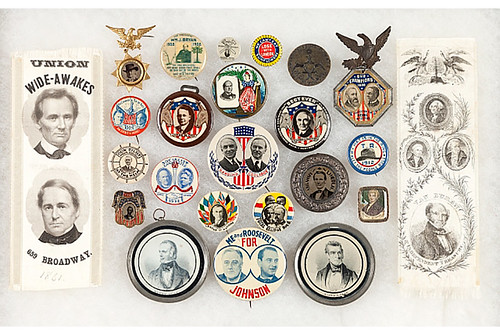
Heritage Auctions announces the sale of the legendary Merrill C. Berman collection of political memorabilia, to be sold in four auctions to take place in Dallas through 2015 and early 2016. Berman's lifelong fastidious approach created one of the finest political collections of important historical buttons, ferros, tokens, and ribbons ever assembled.
"These will truly be landmark events," said Tom Slater, Director of Americana Auctions at Heritage. "Merrill has always been a very private collector. He did most of his buying through auctions and a few trusted dealers, and it has been several decades since the last time any hobbyist was given the opportunity to view the entire collection."
Part I of the collection will appear at auction Feb. 28, 2015. Selections of items from the collection have been displayed publicly on two occasions: at the Hudson River Museum in Yonkers, New York, in 1984 and in 2008 at the Abraham Lincoln Presidential Library and Museum in Springfield, Illinois. However, according to Tom, those displays barely scratched the surface of the collection.
Berman, one of the first 100 members of the American Political Items Collectors, began collecting as a youth but he began to build his collection in earnest around 1970, when success as a stock investor and venture capitalist allowed him to pursue the best material available. "I remember one of my first big sales to Merrill," Slater said. "It was back in the early 1970s and included a beautiful McClellan-Pendleton jugate ferro priced at $2,000. At the time it was almost certainly a record price for any political item. From the beginning, Merrill Berman possessed the qualities which one of my colleagues in the auction business likes to enumerate as defining a great collector: knowledge, taste, financial means, and perhaps most importantly, courage.
"He always recognized truly special material, and didn't hesitate to step up when unique opportunities came along. Not surprisingly he was an active buyer when Don Warner's important collection was auctioned by New England Rare Coin Auctions in 1981. Although Merrill has continued to make the occasional addition to the collection over the years, the collection as it will be offered had essentially taken shape by the mid-1980s."
The Berman Collection now fills some 150 large riker mounts, with very little "filler" material, Slater said. Over the years he absorbed several significant collections, including those of old-time hobbyist Howard Adler and another legendary collector, Stanley King. He was also one of the biggest buyers in the 1981 auction of the Don Warner Collection, up to that point the most important political collection ever offered at auction.
The first catalog of the Berman Collection holdings will be released in early February and lots may also be viewed on HA.com. Additional selections from the collection will be auctioned during weekly internet auctions. Regular Heritage bidders will receive copies of the catalogs by mail. Others may order catalogs starting about a month before each auction by calling 800-872-6467 and asking for the Catalog Order Desk.
To read the complete article, see:
Heritage Auctions to offer The Berman Collection of political memorabilia, across four sales, in 2015 and 2016
(http://artdaily.com/news/75532/Heritage-Auctions
-to-offer-The-Berman-Collection-of-political-memorabilia--across-four-sales
--in-2015-and-2016#.VLGVhCsVhYE)
THE BOOK BAZARRE
MONNAIE DE PARIS ADDS A DINING DESTINATION

The three-Michelin-starred chef Guy Savoy is impatient. A 4,300-square-foot space at the top of the Monnaie de Paris — one of the city’s most beautiful buildings — is scheduled to open this spring as the reincarnation of his flagship restaurant on the other side of town. But the kitchen has no refrigerators and only partial electrical and heating systems. Buckets of water and cans of paint line the floors. Some of the light fixtures have not been installed. Paintings have not been hung.
During a recent visit, Savoy roared through the empty spaces with the same air of authority that marks his reign over his kitchens. Frustrated that the windows in the main dining room were still being stripped of paint, he ripped off the protective paper covering one of them and threw it wide open to reveal the reason he decided to move his restaurant here. Before him was a front-and-center view of the Seine with the Louvre on the other side of the river, the Pont Neuf to the right, the Pont des Arts to the left and the Square du Vert-Galant, a pointy spit of land at the tip of the Île de la Cité, straight ahead. The booksellers on the riverbank below seemed almost close enough to touch.
“Ah, look at this! It’s Paris at your feet!” he said. “There are many beautiful views on the world, but none, none like this one! The first time I saw it, it was like an electric shock. I said, ‘I have to be here.'”

The Monnaie de Paris — the French Mint — is unlike any other hallowed institution in Paris, and the installation of one of France’s marquee chefs here is part of its ongoing transformation. Founded in 864 by Charles the Bald, the grandson of Charlemagne, it is both the oldest institution in France and the oldest factory in Paris. The current building was redesigned and rebuilt in the 18th century and sits on a vast three-acre site on the Quai de Conti. Artisans have turned out coins, medals and decorations in the ateliers here since 1775. Once, all of the coins of the realm were produced here; though France’s official currency coins have been struck in the Monnaie de Paris’s factory at Pessac near Bordeaux since 1973, commemorative coins, jewelry, artwork and honorary medals like those of the Legion of Honor are still made here in Paris.
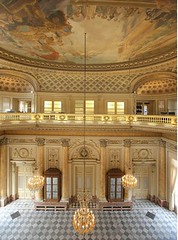 The Monnaie de Paris has long been a little-known and little-visited jewel. With a long, graying,
neo-classical stone façade that could benefit from a cleaning, it does not proclaim its secrets to outsiders. But it merits a visit for a peek at its
grand stone staircase, decorated with medallions and laurel wreaths, alone.
The Monnaie de Paris has long been a little-known and little-visited jewel. With a long, graying,
neo-classical stone façade that could benefit from a cleaning, it does not proclaim its secrets to outsiders. But it merits a visit for a peek at its
grand stone staircase, decorated with medallions and laurel wreaths, alone.
Eventually, there will be exhibits culled from the Monnaie’s permanent collection of 200,000 objects. The 17th-century Mansart townhouse on the site, which has been restored, will be open to the public next year. Savoy will open a brasserie called MetaLcafé in an interior courtyard. When there is enough money, the 22,000-square-foot garden will be replanted and pedestrian streets created. Luxury shops featuring French-made goods and a concept store will be installed in the courtyards and on the new pedestrian streets for both casual visitors and serious collectors.
“Historically, the Monnaie de Paris has been closed in on itself, sort of like Fort Knox in the United States,” said Christophe Beaux, its president. “But it is the only active factory still operating within the city limits of Paris. We have 150 artisans and metalworkers here. Our goal is to open this beautiful beast to the world.” Currently, only 10 percent of the Monnaie site is open to the public; historically, only 20,000 people have visited every year (the numbers went up with the McCarthy exhibit to 1,000 visitors per day during the McCarthy exhibit). Beaux wants to increase annual visits to 500,000 — and for all this to happen by 2016. But work on the project has been slow. The opening of the restaurant Guy Savoy, for example, is already three years behind schedule, the result of French bureaucratic wrangling, environmental and aesthetic concerns and the discovery of massive quantities of lead in the paint and the pipes.
To read the complete article, see:
Long a Walled-Off Secret, the Paris Mint Transforms
Into a Dining and Art Destination (http://tmagazine.blogs.nytimes.com/2015/01/06/monnaie-de-paris-guy-savoy-restaurant/)
Howard writes:
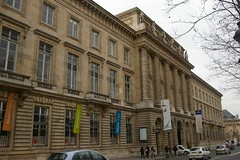 This article brings back a few memories as a visit to the Monnaie de Paris (directly across the Seine from
the Louvre) about 6 years ago was the only time I visited France.
This article brings back a few memories as a visit to the Monnaie de Paris (directly across the Seine from
the Louvre) about 6 years ago was the only time I visited France.
I was invited at a past ANA show by a female employee at the Mint to visit the Mint when I am in London. She personally escorted me around the former museum and the workshops where the decorations/medals are made.
For this trip, I experienced for the first time a round trip ride on the Eurostar train between London and Paris.
It was a nice museum, and it is a shame what is the current transformation. However, it experienced the fate of lack of financial support from the government, just as did the Geldmuseum in Utrecht which was also forced to close.
BTW, you can see a brief shot of the Monnaie de Paris from the nearby Pont Neuf (New Bridge) in one scene in the Bourne Identity (2002) film.
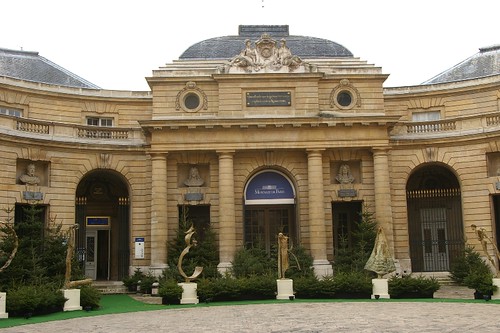
MORGAN DOLLAR MODEL ANNA WILLESS WILLIAMS

The Numismatist, May 1896, printed this item:
“To Marry A Goddess, the Young Lady Whose Profile Appears on Uncle Sam’s Silver Dollars:
“The announcement that the Goddess of Liberty is about to be married has aroused new interest in the woman whose face is known to more people than that of any other woman of the American continent. Every man, woman or child who has a silver dollar carries the handsome profile of the Philadelphia schoolteacher, Miss Anna W. Williams. Her classic features have been stamped upon millions of silver disks.
“It is twenty years since the pretty blonde girl became world-famous. It was then stated that Miss Williams’ profile was the original of the Goddess of Liberty on that much abused, much admired and equally much disliked Bland silver dollar. The friends of the young woman placed every obstacle in the way of possible identification, but failed in their object. The story of how Miss Williams came to be the Goddess of Liberty may be retold, now that it is said she is soon to become a bride.
“In the early part of 1876 the Treasury Department secured, through communication with the Royal Mint of England, the services of a clever young designer and engraver named George Morgan. Upon his arrival in this country Mr. Morgan was installed at the Philadelphia Mint and was assigned the task of making a design for the new silver dollar. After many months of labor the young engraver completed the design for the reverse side of the coin upon which he represented the American eagle. His attention was then turned to the other side, and his original inclination was to place on it a fanciful head representing the Goddess of Liberty. But the ambitious designer was too much of a realist to be satisfied with a mere product of fancy. Finally he determined the head should be the representation of some American girl and forthwith searched for his beauteous maid.
“It was a long search, although pleasant. He told his friends of his desires, and one of them spoke of the really classic beauty of Miss Anna Williams. The English designer was introduced to the girl. Mr. Morgan was at once impressed by her beautiful face and studied it carefully. Then he told her what he desired, and she promptly refused to permit herself to be the subject of the design. Her friends, however, induced her to pose before an artist. After five sittings the design was completed.
“Mr. Morgan was so enthusiastic that he declared Miss Williams’ profile was the most nearly perfect he had seen in England or America. His design for the Bland silver dollar was accepted by Congress, and so the silver coins have been pouring from the mints all these years adorned with the stately face of a Quaker City maiden.
“Miss Williams is a decidedly modest young woman. She resides on Spring Garden Street, not far from the school in which for years she has been employed as an instructor in philosophy and methods in the kindergarten department. She is slightly below the average height, is rather plump, and is fair. She carries her figure with a stateliness rarely seen and the pose of the head is exactly as seen on the silver dollar. The features of Miss Williams are reproduced as faithfully as in a good photograph.—New York Mail and Express.”
To read the complete article, see:
Anna Willess Williams, The “Silver Dollar Girl” (www.stacksbowers.com/NewsMedia/Blogs/TabId/780/ArtMID/
2678/ArticleID/64920/Anna-Willess-Williams-The-%E2%80%9CSilver-Dollar-Girl%E2%80%9D.aspx)
THE BOOK BAZARRE
WWII JAPANESE COUNTERFEITING OF CHINESE CURRENCY
 The Imperial Japanese Army used a private sector company to produce an abundance of counterfeit
banknotes that helped to advance Japan’s front lines in China during the Second Sino-Japanese War, a recent discovery shows.
The Imperial Japanese Army used a private sector company to produce an abundance of counterfeit
banknotes that helped to advance Japan’s front lines in China during the Second Sino-Japanese War, a recent discovery shows.
Researchers at Meiji University studied 279 sheets, each about 30 centimeters square, that were left at Tomoegawa Co.’s paper mill in Shizuoka. They concluded that the sheets were part of the army’s operation to fake banknotes used in the Republic of China during the war.
The army’s Noborito institute in Kawasaki had placed an order for the sheets with the Tokyo-based company. This suggests the army institute was involved in not only developing biological weapons, balloon bombs, toxins and other confidential defense technology but also in counterfeiting money.
The remains of the army institute are now preserved as the university’s Noborito Institute Peace Education Resource Center, which opened in 2010 in Tama Ward.
 According to the researchers, the sheets showed watermarks of a profile of Sun Yat-sen, the Chinese
revolutionary and founding father of the Republic of China. They also contain silk fibers.
According to the researchers, the sheets showed watermarks of a profile of Sun Yat-sen, the Chinese
revolutionary and founding father of the Republic of China. They also contain silk fibers.
These features are identical to those of a 5-yuan banknote that was widely circulated in the Republic of China at that time.
Other sheets found at the mill had watermarks of the Temple of Heaven, a historic structure in Beijing, that appeared on a different kind of 5-yuan bill back then.
A former Imperial Japanese Army officer who was in charge of the counterfeiting project wrote in a postwar book that the operation had created fake bills worth 4 billion yuan since its start in 1939.
Akira Yamada, professor of modern Japanese history at Meiji University, said it had long been thought that paper for the fake bills was produced only at the army institute because of the highly confidential nature of the operation.
“Having a company in the private sector involved in the project made it possible to make a vast volume of banknotes,” said Yamada, who is also head of the Noborito institute. “Japan was able to expand its battle lines in China apparently because it could secure supplies to continue fighting with a wealth of forged banknotes.”
The sheets were produced between August 1940 and July 1941, the researchers said, citing the letters printed on them.
The researchers’ findings came after they sent inquiries to companies that had business dealings with the army institute, which was inaugurated in 1937.
Most of the army institute’s facilities and documents were destroyed when Japan was defeated in 1945.
To read the complete article, see:
Researchers: Japanese army used private paper mill to counterfeit
Chinese bills in war (http://ajw.asahi.com/article/behind_news/social_affairs/AJ201501060039)

MACQUARIE UNIVERSITY INVESTIGATES ANCIENT COIN MANUFACTURING
Researchers at Macquarie University's Australian Centre for Ancient Numismatic Studies (ACANS) have joined forces with scientists from the Australian Nuclear Science and Technology Organisation (ANSTO), on a joint research program to solve a twenty-five century-old mystery behind the technology used to produce a special variety of ancient Greek coins.
First minted around 540 BC in the cities of Southern Italy (modern Basilicata and Calabria), incuse coins show the same image on the front and back – but the image on the back is sunk into the metal so that it appears as a negative or incuse version of the front.
The mysterious technique of manufacture, which appears to be quite difficult to execute, has attracted a good deal of discussion but it has never been satisfactorily explained. We do know, however, that these cities continued to mint these coins for over a century.
There are no surviving contemporary accounts of ancient coin manufacture, and no illustrations. Only three or four of the dies once used for striking coins in ancient Greek mints survive today. Therefore, what we know about the earliest history of coin minting is derived from a study of the coins themselves.
With the emerging science of neutron scattering, the use of neutron diffraction to improve our understanding of the techniques of ancient coin manufacture is just beginning, and the ANSTO/ACANS study is among the first.
"Our aim is to explore the technology behind the production of one of the world's first coinages," explains Dr Vladimir Luzin, Instrument Scientist at ANSTO. "In particular, our objective is to explain the very singular technology and processes for minting incuse coins."
"ANSTO's neutron scattering texture measurements will provide insight into the mechanical processes undertaken to create the coins," explains Associate Professor Kenneth Sheedy, Director of ACANS.
"Numismatists from ACANS will then infer the production steps undertaken to produce these coins using knowledge of ancient materials and equipment that were available at the time."
Macquarie University's Numismatic Centre holds one of the finest collections of South Italian coins in the world (there are 1267 coins specimens in the Gale donation). This research partnership with ANSTO will help to enrich the Centre's knowledge of this important university resource.
To read the complete article, see:
Uncovering twenty-five century-old mystery behind ancient Greek
coins (http://phys.org/news/2015-01-twenty-five-century-old-mystery-uncovered.html)

Silver Stater from Lucania Metapontion, 510-480 BC: Obv. Ear of corn, META reversed; Rev: Ear of corn incuse [Credit: Rosenblum Coins] First minted around 540
BC in the cities of Southern Italy (modern Basilicata and Calabria), incuse coins show the same image on the front and back – but the image on the back is sunk into the metal so that it appears as a negative or incuse version of the front.
To read the complete article, see:
Twenty-five century-old mystery
uncovered (http://archaeologynewsnetwork.blogspot.com/2015/01/twenty-five-century-old-mystery.html#.VK3Z5isVhYE)
SOME RECENT COIN DESIGNS: JANUARY 11, 2015
Hungary 2000 Forint Coin on Abraham Ganz Bicentenary
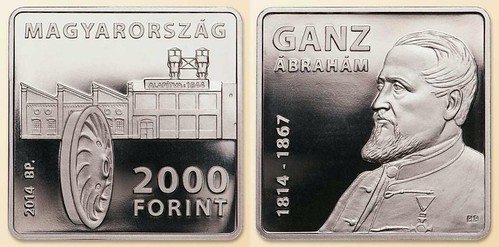
Ukraine Coin on Ozbek Han Mosque and Madrasa


Ukraine Coin on Vasyl Lipkivskiy

Finland Coin on Jean Sibelius
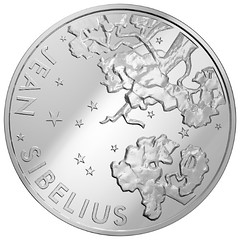
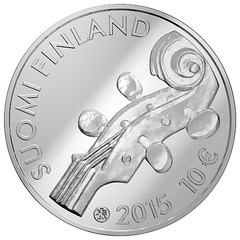
The Jean Sibelius collector coin represents Finnishness at its most profound. It is a beautiful and touching gift with a place in the home of any Finnish person or music lover of any nationality.
The collector coin's obverse depicts the starry sky of Ainola and a copse of pine trees, among which Sibelius was often seen lost in thought. The reverse bears the neck of a violin, the composer's favoured instrument.
The collector coin struck in honour of the 150th anniversary year of Jean Sibelius (1865–1957) commemorates the master composer's remarkable oeuvre and influence on the Finnish national character and Finnish classical music. The Sibelius collector coin touches every Finn and represents a piece of Finnishness to people of other nationalities.
To read the complete article, see:
Jean Sibelius collector coin 10 €
(www.suomenrahapaja.fi/eng/jean-sibelius-juhlaraha-10-/17945/dp)
Ireland Coin on Ernest Walton

Ireland will issue a 15 Euro coin in honour of its Nobel Prize winner, Ernest Walton. Walton, with John Douglas Cockcroft, shared the 1951 Nobel Prize in Physics for their pioneering work on the transmutation of a nucleus by artificially accelerated atomic particles. The design on the coin gives an artist’s impression and explanation to the equation we all know, E=mc2.
THE BOOK BAZARRE
PSYCHOLOGIST TRAINS MONKEYS TO USE MONEY
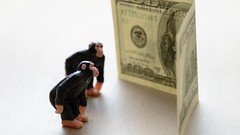 Laurie Santos
heads the Comparative Cognition Laboratory at Yale University. In that lab, she and her colleagues are exploring the fact that when two species share
a relative on the evolutionary family tree, not only do they share similar physical features, but they also share similar behaviors. Psychologists
and other scientists have used animals to study humans for a very long time, but Santos and her colleagues have taken it a step further by choosing
to focus on a closer relation, the capuchin monkey; that way they could investigate subtler, more complex aspects of human decision making – like
cognitive biases.
Laurie Santos
heads the Comparative Cognition Laboratory at Yale University. In that lab, she and her colleagues are exploring the fact that when two species share
a relative on the evolutionary family tree, not only do they share similar physical features, but they also share similar behaviors. Psychologists
and other scientists have used animals to study humans for a very long time, but Santos and her colleagues have taken it a step further by choosing
to focus on a closer relation, the capuchin monkey; that way they could investigate subtler, more complex aspects of human decision making – like
cognitive biases.
One of her most fascinating lines of research has come from training monkeys how to use money. That by itself is worthy of a jaw drop or two. Yes, monkeys can be taught how to trade tokens for food, and for years, Santos has observed capuchin monkeys attempting to solve the same sort of financial problems humans have attempted prior experiments, and what Santos and others have discovered is pretty amazing. Monkeys and humans seem to be prone to the same biases, and when it comes to money, they make the same kinds of mistakes.
Santos and her colleagues created something they call the monkey marketplace, an enclosure where those monkeys could comparison shop with their tokens. Inside, human merchants offered deals for grapes and apples, some better than others, some risky and some safe, and the tiny primates picked up on these factors, changing their behavior in exactly the same way as humans. In fact, Santos says that on paper, across many experiments, you can’t tell capuchins and humans apart.
To read the complete article, see:
Monkeys, money, and the primate origins of human irrationality
(http://boingboing.net/2015/01/09/monkeys-money-and-the-primat.html)
WORST. COUNTERFEIT. EVER.
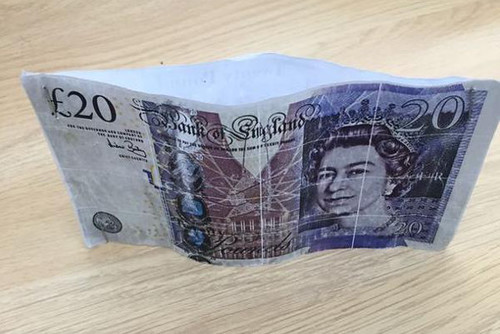
What must surely be one of the most feeble attempts ever to counterfeit a £20 note was enough to fool one Manchester shop worker.
The fake consisted of two photocopies - and poor photocopies at that - cut to size and loosely stapled together. It was accepted by a Manchester bar over the Christmas period and later handed in to the police.
Greater Manchester Police has posted an image of the fake on Twitter to raise awareness.
"Hard to believe that this was accepted as legal currency. Won't name and shame establishment to avoid embarrassment," they say.
While it might seem impossible for anyone to fall for such an obvious fake, Manchester's Pub and Club Network spokesman Phil Burke told the Manchester Evening News that it's an easy mistake to make in the circumstances.
"I have seen something similar to this recently in Manchester. I saw it on the floor and went over to pick it up thinking I'd found a £20 note and everyone was laughing at me," he said.
"They look real from a distance but not close up. But perhaps if you're working in a nightclub which is very dark with flashing lights, you might not spot that it's fake."
Forged bank notes are rarely perfect: they just have to be good enough to fool a bored or distracted sales assistant. Special pens and UV lights are available to help staff spot fakes but are rarely used, especially for smaller denominations.
To read the complete article, see:
Worst fake £20 ever? Two photocopies stapled
together (http://money.aol.co.uk/2015/01/08/worst-fake-20-ever-two-photocopies-stapled-together/)
MAN AWAKING FROM COMA REACHES FOR BANKNOTE
A man who had been in a coma for more than a year was recently woken up by a 100-yuan (S$22) banknote, Southern Metropolis Daily reported.
Xiao Li fell into coma after spending days without sleeping at an Internet bar in Shenzhen, South China's Guangdong province, in August 2013.
In March 2014, he started reacting to the outside world by flickering his fingers and moving his eyes.
When a nurse took out a 100-yuan note from her pocket and swayed it in front of Xiao, he held up a hand to grab it.
Although it took him five minutes to grab the note, the doctors said the move showed that Xiao has regained consciousness.
It may still take a while for the lucky man to recover fully before being finally discharged from hospital.
To read the complete article, see:
Banknote wakes up man in coma
(http://yourhealth.asiaone.com/content/banknote-wakes-man-coma)
FEATURED WEB SITE: GUATEMALAN COINS
This week's Featured Web Site is suggested by Rich Hartzog. It's a commercial site, but has nice articles on the history of Guatemalan coinage, including a list of some 1000 known Guatemala tokens. Click on the History links to the left to view the articles in the center pane.Since the arrival of the conquistadores in 1524 in Guatemala, European currencies started to circulate, primarily Spanish and later on Mexican, Peruvian and Bolivian. They are used in very small amounts and mostly of high-value, since coins of a fraction of the currency are almost nonexistent, which is why the use of the native currency pattern (cocoa shells, feathers and skins, among other things) was predominant in the early years of the conquest and coexisted with the use of currencies, mainly with the indigenous population until the late nineteenth century.
Because along with foreign currency, lots of counterfeit currency came in, of low grade or altered. local authorities in 1662, after hearing about the Potosi Mint scam proceeded to counter-mark with a crown (pictured above), coins of 2 reales from Lima and Potosi which had the weight and lawful title, trying to distinguish them from the low grade and adultered ones and prevent fraud. These coins are known by the name of Moclón, being the first Guatemalan numismatic items, which are known to be two different types of crowns. But coins with a lower grade of gold or silver continued to come in and circulate, especially tepuzques (copper,in Nahual language) small discs of lesser quality or adulterated gold without title, only weight value, which circulated in Mexico around 1522, and later in Guatemala.
The Royal Mint was built in Guatemala under the decree of his Majesty King Philip V of January 20, 1731. It was the fourth in America, after Mexico's in 1537 Peru's in 1565 and El Potosi 's in 1572. But it was not until January 17, 1733, that Guatemala received seals and other necessary instruments, from the Mint of Mexico. It had recently received new tools in order to manufacture round coins. On March 19, 1733, the first currency in Guatemala was coined, a doubloon of sixteen escudos (shields).

www.monedasdeguatemala.com/indexIN.html

